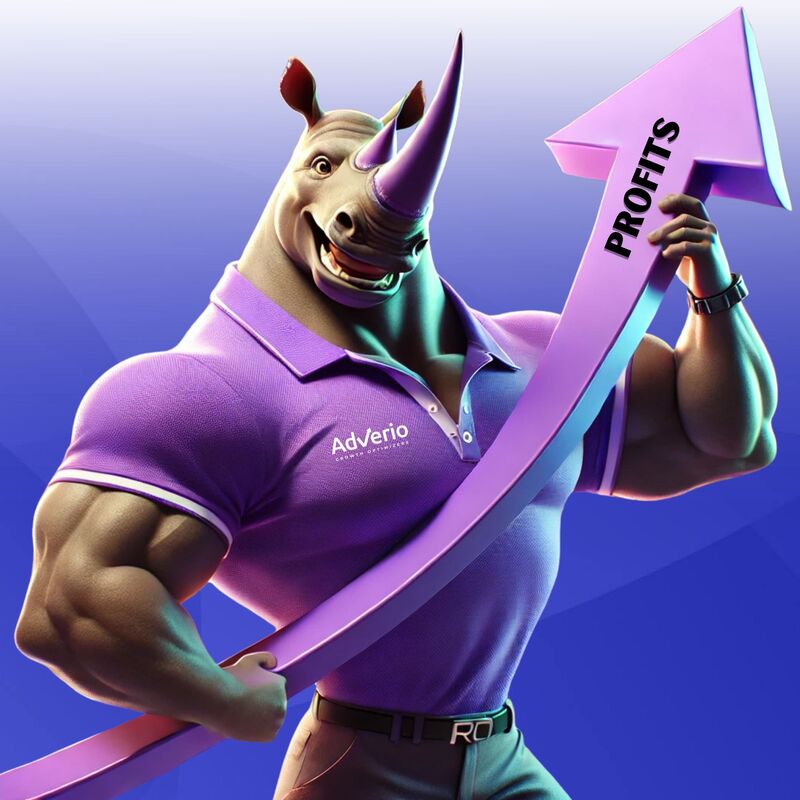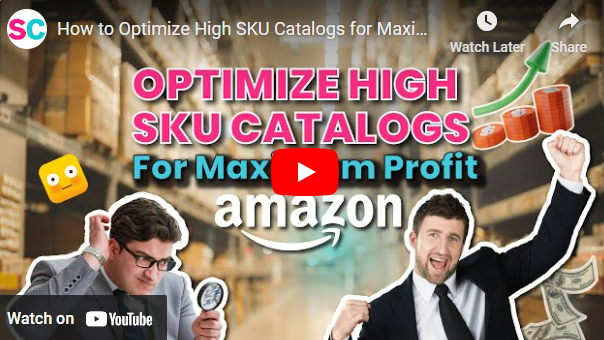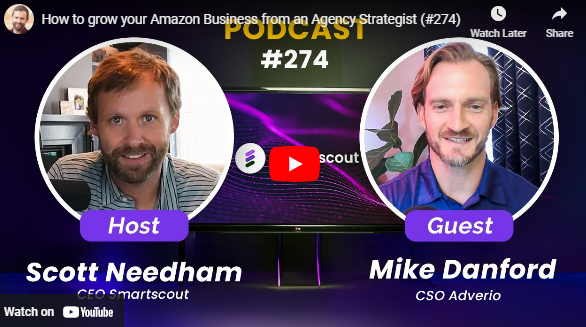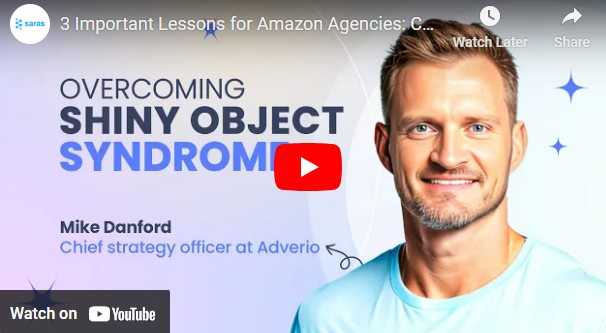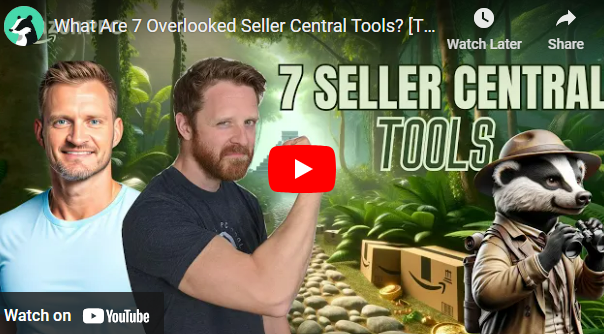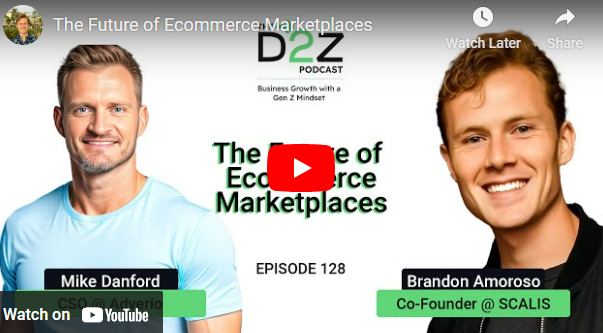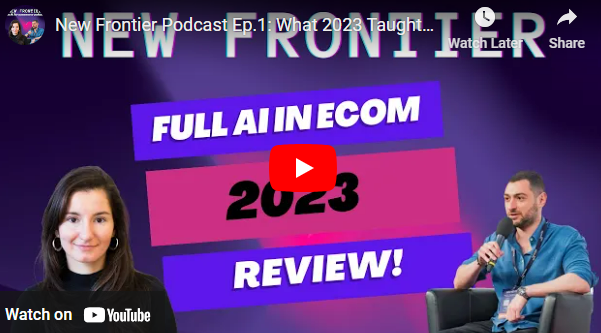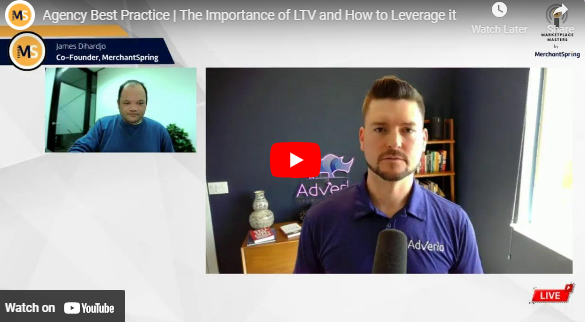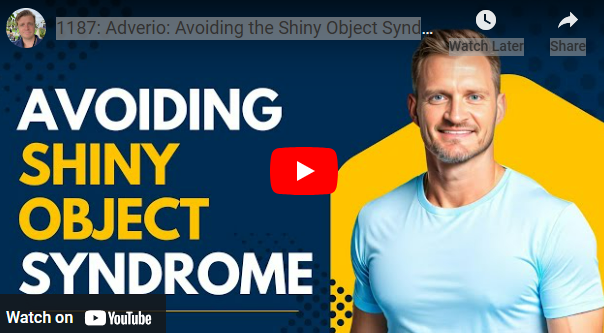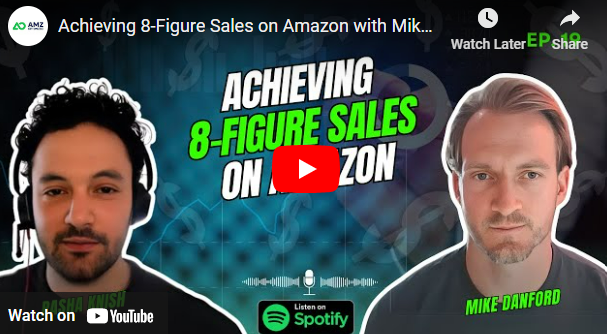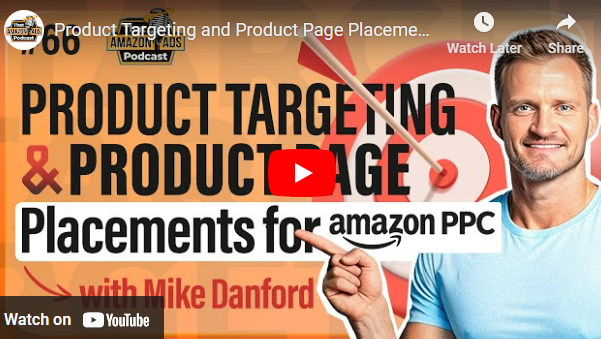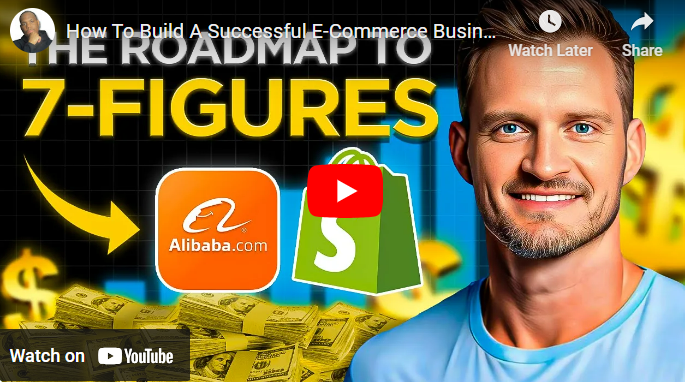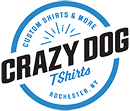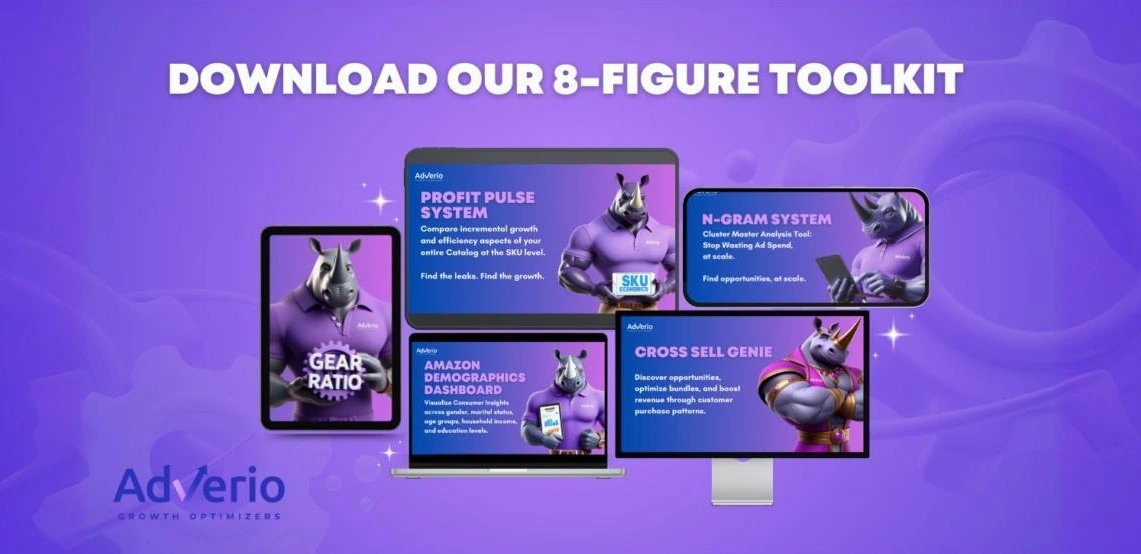PPC Den Podcast
The world's first and longest running show all about Amazon PPC
Curious about the best-kept secrets that can elevate your Amazon selling strategy? In this episode, Michael sits down with Mike Danford from Adverio.io to uncover seven often-overlooked tools within Seller Central that can transform your business. These tools offer game-changing insights, from enhancing your advertising strategy using Search Query Performance data to managing profitability with SKU Economics. You’ll also discover how the Product Opportunity Explorer can help you identify untapped market potential, plus strategies for brand reputation management, crafting custom promotions, and optimizing influencer marketing through Creator Connections.
What this podcast covers :
- 00:01 New tools in Seller Central for better ad campaign management
- 02:53 Discussion on the role of a Chief Strategy Officer (CSO)
- 07:00 Leveraging seller tools for revenue growth and forecasting insights
- 08:50 Analyzing search query performance data for better optimization
- 12:51 Utilize seller central tools for holistic view of catalog and improve efficiency.
- 14:46 Utilize the Skew Economics dashboard for detailed profit analysis.
- 18:29 Product Opportunity Explorer helps in market growth or contraction analysis
- 20:11 Customer review insights and returns are valuable for product improvement and trend analysis.
- 23:28 Leverage Market Basket Analysis for Product Bundling
- 25:12 Utilize ‘Market Basket Analysis’ report for targeted advertising
- 28:39 Seller Central Tools: Managing customer refunds and reviews.
- 30:16 Managing product reviews and ratings
- 33:44 Utilizing seller central tools to create targeted promotions.
- 35:30 Optimizing storefront for increased followers and organic campaign
- 39:01 Creator connections is Amazon’s compliant influencer marketing within Seller Central platform.
- 40:51 Utilizing Amazon’s tools for increasing outreach and engagement
- 44:20 Engaging with customers through brand reputation and customer reviews
- 46:05 The role change and focus on creating content
Transcript
Michael Erickson Facchin: [00:00:00] What’s going on Adbadgernation. Welcome to the world’s first and longest running show all about Amazon PPC to make your Amazon advertising life a little bit easier and a little bit more profitable. I’m really excited today because we have a great show with Mike Danford from Adverio. Where we basically do a tour of seven tools inside Seller Central that if you click on them and you haven’t clicked on them before, you will surely get value almost immediately.
So really actionable stuff here, new tools in Seller Central to help you better think about and manage your ad campaigns. Let’s jump into the episode.
Mike, welcome to the show. Welcome to the Badger Den. How are you doing today?
Mike Danford: I’m great. Thanks so much for having me today.
Michael Erickson Facchin: Fun fact, and I didn’t tell you this. I’ve never told you this, but the ad vario accounts that you guys manage are so big that when you signed up for ad badger, we embarked on probably a month long [00:01:00] sprint.
To upgrade our servers just to make everything faster. So I thank you for pushing us. It was it was awesome. You guys are seem like you’re doing amazing things over there at Adverio. Thank you for coming on board.
Mike Danford: No, I definitely appreciate it. I know it was a little rough in the beginning, hitting you with the large accounts, but you definitely stepped up and we appreciate that.
Michael Erickson Facchin: So for anyone who, so this is your first time on the PBCN podcast, for anyone who doesn’t know, Who you are. Why don’t you introduce yourself to the crowd?
Mike Danford: Sure. Yeah. So Mike Danford, CSO for Adverio. I’ve been in the Amazon space since 2010 started launching a brand and then realized that my most expensive cost was paying someone to do the advertising for me realized it was just numbers and went from there.
And then others started seeing the results and asked if I’d do it for them. And then obviously the rest is history from there.
Michael Erickson Facchin: A CSO for anyone who doesn’t know, what does that stand for? And what do you do on a day to day basis? [00:02:00]
Mike Danford: Great question. So chief strategy officer, there’s multiple ways to go with that.
Obviously for the organization is strategic partnerships, et cetera, like that, but also like to get into the weeds on the strategy for sponsored ads, DSP, et cetera, like organizational strategy as well. I have my hands on a lot of different things. I also get into the tech side as well. So I love that.
But it’s trying to make sure everyone’s going the same direction that we’re all aligned.
Michael Erickson Facchin: And tell me about the rhino mascot. Obviously I’m a big fan of companies with animal based mascots. Tell me how the, tell me how the Adverio Rhino came to be.
Mike Danford: Obviously you can see we have a Rhino there. It’s my daughter’s Winston. She gave it to me and then just Hey, we need something that’s strong, burly. And then the AI generation that we have now with the personified Rhino has just been so fun for the team. So we love it.
Michael Erickson Facchin: That’s awesome. It’s good to have. It’s nice because you just, you get a lot of. Of the animals branding right on board. So it’s great. And I’m so [00:03:00] excited to have you on the show. Cause we’ve been talking for a couple of months now and it’s been really great. And I love the way that you think about things and approach things.
You have a really cool topic for today, which is really, we’re going to do fast and furious here. We’re going to cover. Seven parts of Seller Central that to be honest, when I like look at these seven parts, it’s really if the homework for today for anyone listening is to literally just go into these seven tools, click on them, and you will immediately be inspired to take action.
You’ll find almost immediate value in a lot of cases. Some of these we’ve talked before about, but I, but it’s definitely a constant reminder. I just I was just talking to a rather successful brand and they didn’t have one of these that we’re going to touch on. I’m just like, Oh, like just add that that’ll be really easy for you to find value.
Another one of these we know someone who didn’t, again, another successful brand didn’t have one of these, turn them on and like immediately found [00:04:00] value in the first two weeks. So I feel like those things are it’s always so nice when you’re able to do that. So thank you for bringing these.
Seven things that people can get value for. And with that, let’s jump into the first one. Alrighty, Mike, the first one search query performance. This is probably every Amazon marketer who I know. Probably favorite thing in the last two years. I know that I personally love it cause it gets Amazon gives you search volume, total amount of impressions, tells you your brands or your products, impressions all the way down the funnel to purchases.
Like how many purchases came from this amount of search volume and what your brands share was and those are some of my favorite reasons, but there’s a big problem with the search query performance report, which is it’s really hard to like It’s really nice to look at, but it’s really hard to take it to the next level.
So tell me what you love about the [00:05:00] search query performance report and like what problems you experienced with it and like how you guys and how you recommend people navigate this stuff.
Mike Danford: Absolutely. The biggest thing is, a lot of these tools that Amazon releases, a lot of information, it’s really hard to digest.
You have to bolt on some kind of way to manipulate it and spin it up and try to get the insights from it. If you’re willing to do that, you can really go to the next level. So with that, our biggest takeaway or gain is, looking at the total addressable market through the report.
And then there’s a way that we work out to understand what the potential revenue bump is if we were to push and pull certain search queries both from optimizing the listing, putting in images, et cetera. And then what’s the quickest levers that we can pull on the advertising side, especially when we were able to marry the advertising data to it.
There’s just so much there. And then, there’s a couple of other use cases. Obviously there’s been three or four podcasts with you that do that. So I won’t beat it that horse there, but it also helps us. It’s one of our main things we do for due diligence, taking on a brand, helps us [00:06:00] understand where they’re at, including get into price and elasticity as well, and it like.
Understand, are they already doing well? What’s the quick leverage we can do here? We have one, two, and three phases, along how long it’ll take. And then one of the most common questions we get, it’s around forecasting. It’s hey, how much can I grow? And then obviously the second part of that is how much is it going to cost me to grow?
And is this sustainable, right? So that’s our real goal is to try to understand those in that order. I know your latest podcast with Destin kind of mentioned forecasting is dead since 2020. I’m with her. It’s definitely more challenging but this definitely helps us to understand the quick wins or where we can go.
I should mention we, it’s only one part of the puzzle, so try to keep that in mind.
Michael Erickson Facchin: Yeah. A couple of things that I’ll also comment on it is. I think it’s very true that I remember the first time they came out with a search query performance and I’m showing it to an Amazon seller and their mind was blown.
They’re like, Oh my goodness, I had no idea this thing existed. This was, over, I think it’s been out for over two years now. And then I think that, just a couple [00:07:00] months ago, maybe two, three months ago, I showed it to another Amazon seller and their mind was blown. So I think it’s so easy.
Like we have a lot of high level optimizers on the show and we all know it, we all love it. We all are able to download it and manipulate and do all these cool things with it. But I think that it’s also very hard to get into, right? It’s like what you exactly said. I love it because you can download it.
You can say this is my share of all of these searches. And then you can begin to ask questions like what if I increased my share on these families of keywords a little bit, how much am I spending on it? How much am I spending on these keywords right now? Imagine if I were to spend a little bit more and get a few more orders, how would my market share change?
So but in order to get that, you need to download it. And you need to do stuff with it. And I know that internally we’ve played around with building spreadsheets where you download a bunch and you put it in there and it gives you a [00:08:00] spreadsheet, a good friend of the show, men sore from incrementum digital also has something like that, where you download it, you put it in a spreadsheet.
But what I think is cool. You also have, I also, yours has the best name. Men’s sore has one called the S U P a. Super. I dunno if you’ve ever seen it, but I scratched my head. I’ve actually never asked him what it stands for, but it’s just like a search query performance analyzer. Yeah. But I really like the name of your guys’ Spread sheet tool, which is Query iq, QRY iq.
I was like, what is this query? I, because I see query in there iq, query iq. So tell me with search query performance data, what I wanna focus on is like another lens to analyze this. So what do you guys do with search query performance? What do you do with this report?
Mike Danford: So there’s a lot of use cases.
We have several brands that are larger. So I know when Mena was on here, he was talking about like, why would you ever use the brand report as you open, we work with large accounts, high skewed accounts, 100, 000 SKUs, right? So we have to go with the brand level. And the big thing [00:09:00] is looking at the comprehensive report.
It gives us a couple thousand extra terms sometimes depending on the brand and depending on how it is. But it really shows us that Pareto of across, multiple products at the same time, what to go after, and then we can obviously figure out which products it is and delineate which ASIN is on the back end based on advertising, et cetera.
But what we love to do is look at, we have several brands that have some pretty large tent poles, random tent poles that, it’s like, they’re only like the end of one and then you have others. We just had St. Patrick’s day for a brand. And what we did is we looked at this SQP from last year during the ramp up four to six weeks prior to the event and we’re like, Hey we could have really pushed this unit.
So I’ll give you an example of the ASIN sold like 40 or 50 units and we took the top 10 that we knew we just had better conversion click through everything, et cetera from. Build a dedicated campaign, it’s over 500 units over the same time frame versus the prior year, just by taking that data. So we do the same thing with helping us with our SEO and indexing is say, Hey, for the seasonal terms let’s [00:10:00] put these in here, whether it be in the backend, rotating all texts, anything of that nature.
Michael Erickson Facchin: So it helps us just juice seasonality. Yeah, I love it. So we actually have a, you actually have a freebie for everyone to go and download. There’ll be a link in the description there. Again, everyone go collect these all these different search query performance analyzers.
They’re so valuable. So thanks for bringing it. And with that, let’s jump to the second one.
Alrighty. This second one. Skew Economics. Talk to us about this.
Mike Danford: All right. So this has been available at a individual skew level for quite a while. I’m not exactly sure when it came out, but they more recently released it where it’s aggregated, where you can look at a holistic view of your catalog.
Again, as we mentioned, we have large catalogs. So it’s really nice to have these all in the same, one screen. It’s pretty, pretty insightful for a lot of sellers to see how the, how many different fees. This is a fee stack from Amazon from selling it to the referral to fulfilling it to the returns and everything.
So it’s really interesting to see [00:11:00] that. A lot of brands, we have, we develop our own tools called the profit sorry, profit pulse system, which is very similar to that. And we take all that data put together and we create heat maps. Based on, looking at the top five or so categories, ROI, margin, total revenues, ad sales, and organic, what that really helps us do is look at, okay, this ASIN is our top seller.
But it’s our number 10 spender. Is that what we want? Is that good or bad? Or, hey, this is our number 10 seller, but it’s our number one spender. So it really helps us to understand and recalibrate if we’re pushing the ad spend to the right place. A lot of brands don’t they focus on margin and tacos and relay costs and a few other things.
But when we pull in, net profit after all feeds divided by COGS is how we get into ROI. It really helps them understand, again, we work with large catalogs. Let’s kill the dead weight based on this. And we can increase our efficiency within a couple of weeks just by showing them this.
Especially whenever they have. Filming issues or trying to understand, [00:12:00] or it can be easily shift things around. And there’s a ton of uses for this, but I highly recommend doing it. It’s not the easiest to find right now. Do we walk you through how to find it or do it? Yeah. So you’ll go into your inventory section.
You can do by manage all inventory. You have to click on the actual SKU link. And when you pull it up about two thirds of the way down, there’s a table there that’ll show you the SKU economics for that ASIN or that SKU depending on what you select. Now, right below it, there’s a new prompt that says.
Skew economics, like dashboard or report, click that and it’ll pull everything together for you.
Michael Erickson Facchin: So this is really cool because, I know that a lot of people use third party tools to basically try to extract a lot of this information, which is, returned items, any Amazon fees. And there are several different kinds of Amazon fees, but really at the end of the day, you want to know.
How much did I spend on something? And then at the end of the day, like what was that profit at the end of all of that? Which is actually, it’s a very different metric than like [00:13:00] total ACOS or at cost of total sales. It’s a very different metric. I’m curious when you have. Tell me a little bit about the frequency of when you look at that.
Do you look at that maybe on a monthly cadence? And if so, like the last time you did this, what were the action items from it, from like a real account?
Mike Danford: Yeah, absolutely. So it’s updated daily in our dashboard, so you can pull it at any time. Generally it’s one of the, when our kickoff call or first coming in sometimes during our audit, depending on where we’re at in the cycle with them, what they’re looking for and it’s really, it’s a monthly basis.
Hey, let’s move some spin around. Let’s do some different things here. Let’s understand what’s going on. And then obviously with these new Amazon fees, there’s a whole, there’s a whole lot of things you can get into as well with the low inventory and long term storage, et cetera. So it helps us understand.
moving prioritization, et cetera. And then it’s pretty impactful with us on, we have a couple of brands that, one brand launches two or 300 SKUs a month. We have another one that does a couple of dozen a month. And it really helps us to, Hey, take this amount of spending, [00:14:00] keep it on your, the ones that are more mature in a product life cycle.
And then let’s reallocate this spend here. And then, look at the level is really, we love, I know green. This was green. She has a good report too. I think I’ve seen where she’s looking at ad conversion versus total conversion rate. And we love that as well. To understand if the push is worth, the squeeze is worth the juice was a squeeze.
Michael Erickson Facchin: Is the advertising improving the organic or the conversion rate? So there’s a lot of ways of looking at that for sure. All right, this one’s definitely one of my favorites. The Product Opportunity Explorer. So give people a quick overview of what the Product Opportunity Explorer is first.
Mike Danford: There’s lots of ways. Most people probably are familiar with Helium 10 third party tool. It’s very similar to that where you can go in and look at, quote unquote, niches based on search terms, ASINs or above.
You can pull in your brand, look at other information. It gives you a lot of metrics across the top basins or search results for that is really insightful. Just going in and looking at it can be overwhelming for sure.
Michael Erickson Facchin: Yeah, I love that you started [00:15:00] with, the first wave of Amazon tools were all sort of market niche explorers generally from the angle of go launch a product.
Here’s how to go find a good niche, right? And that’s evolved a lot over the years. To now where now Amazon has a lot of that information available to you where they’re telling you things like search volume and if the search volume has gone up or down and you know what they define as a niche and like what the search terms are of that niche and which ones lead to the most conversions and who’s the top converting one.
So it tells you a lot about niches, which it generally defines as a, I think it gives you 20 keywords every time. So like it says, this is a niche. These are the top sellers for these niches. This is how much each term is for the each search terms is how much searched. So I love this tool.
I’ll tell you the way that I use it a lot. I use it for like market growth or market contraction. So if I would, the general feedback loop is if a advertising campaign shrinks, maybe revenue [00:16:00] goes down, I go over to the product opportunity explorer and then try to identify are there more because it’ll tell you, it’ll tell you how many people have launched in the last 90 days, so I’ll be dealing with a lot more competitors.
The Product Opportunity Explorer can tell you that first party. It’ll tell you like the average review rating. And then you can compare that your product versus there. It’ll tell you if the overall search volume has gone down. So it’s okay, like maybe we don’t need to panic if the overall search volume has gone down.
Maybe we’re out of season or something like that. I also like to look at it and who are, who is the number one clicked product for this niche for these keywords? Let me see what they got. And what I can learn do is do a little competitive analysis.
So what are some of the ways that you incorporate it in your workflow?
Mike Danford: Oh yeah, you definitely nailed the several of our use cases for us. I want to iterate, this is definitely a 1P data set.
So I love that versus what we used to have. Again, it’s not always reliable, but you have to take it for what it is from Amazon, it’s all relatively right. But you mentioned like our biggest uses are getting into the customer review insights and the returns is really insightful because they usually work [00:17:00] hand in hand, especially on the negative sentiment side.
Okay, you got a lot of returns and you can see that come through in the reviews and it can help you, change your product or understand what the opportunities are from there. And the list goes on for, we have several brands that you know, launching a lot, trendy.
Like those tentpoles again so this really helps to understand like a recency bias, say, Hey my product’s been on there for two or three years longer than the top seller. Why is it? They’re tapping into that recency bias, that fad, if you will,
Whatever’s popular. It could be a color, a style, a size semantics in the product, whatever it may be.
So it really helps you to find those trends directly on the platform.
Michael Erickson Facchin: Yeah, I love it. So if you haven’t checked out the product opportunity, explore, click around. I absolutely love it. Hey y’all, it’s Mike here. I hope you’re enjoying the episode. One tool that we didn’t mention in the interview was actually.
Ad badger. I know it’s not a seller central tool, but it’s a tool that a lot of sellers use to better think about manage and optimize their Amazon advertising campaigns. For example, [00:18:00] we have our search term Ngram analyzer, which will help you clean up all those search terms that you look at. And you’re like, these only has one or two clicks.
Like what do I do with this thing? We’ll be able to analyze and aggregate information for you, allowing you to easily just click, pause, or click, maybe promote, maybe order to keep it. A little bit more. You can do day parting where you can bid up and down. So you can actually see when your products make the most sales and you can go ahead and take action on them.
Say, I want to give it a 20 percent boost here because this is where the bulk of my orders come from. And on the weekends in the middle of the night, I barely get any sales. So I’m going to reduce my bids 10%. So you can do really cool stuff like that. Anyway, if you want to check it out, we have a link in the description where you can maybe watch a video, take a tour or talk to somebody on the team about what it might look like for you to jump into the Badger Den as a software customer.
Anyway, have a good one. Let’s get back to the show.
The market basket analysis. I’m really actually very curious on your perspective [00:19:00] on it, because I know you work with a lot of clients. with very high skew counts. So tell me a little bit about how you guys use the first of all, tell us what the market basket and that analysis is, and then how you guys actually work it into your workflow.
Mike Danford: Yeah, absolutely. So at a high level, it’s Amazon telling you what the other two ASINs are purchased with your ASIN that is purchased. And there are ways to look at, your own branded ASINs, like if they’re purchased with your own brand. Multiple purchases of your brands and also your competitors as well.
So that’s the two views that we look at.
Michael Erickson Facchin: So when does this come up? Like when are you sitting at your computer? Oh, I better go check this out in the market basket report.
Mike Danford: Absolutely. So we do it first. We bring an account on, especially a brand that’s Hey, we want to know where our next product is, or we’re trying to figure out what to do, It’s pretty wild what you can find in here, obviously on the PDP or the product detail page, you can see we’re frequently bought together but that rotates around and that’s, got some bias around Amazon where this will actually show you. Pretty common that we’ll go in and we’ll find products.
Again, I mentioned, we’d look at, what other ASINs in [00:20:00] our catalog are they purchasing and giving out large quantities.
So it’s Hey, what is frequently bought together of our own brand? Can we put those in bundles? Can we put those together? Why are they separate? Can we parent them together? How can we join those and make the cart size larger? Because, merchandising Amazon, you don’t want to have to click around for a lot.
And the other part is, a use case we just had for a new brand that came on. This was awesome. They were selling smudge sticks and we go in and we run the market basket analysis for them and we show them. One of their top sellers, I think it was number three, 59 percent of the time that body was purchased, they were purchasing a Palo Santo type stick.
Yeah. I didn’t know what that was. I’m not familiar with that space. And they weren’t aware of it either. Guess what they offer now? Bicento stick. And it more than doubled their cart size for that product. They’re able to actually increase the cart size, individual price and combined price. It’s really awesome.
Michael Erickson Facchin: Are you, let me, I just want to confirm if I missed that. Are you saying that they began, they use that as Market research and began to develop their own. Absolutely. [00:21:00] Santo stick. Yeah. Absolutely. Wow. Right on. So that’s really cool. I was going to say, is another use case where you look at what’s being purchased in combination with your product, and then you go and you actively target that product with different kinds of advertising so that you appear on that sponsored placement on you appear as a sponsored placement on that.
Product page for that.
Mike Danford: Absolutely. Yeah. Cross sell compliments, supplements, all that kind of stuff. Absolutely.
Michael Erickson Facchin: I love it when I love it. Anytime things like this happen, we’re just like, cause I think a lot about campaign structure, like how do we advertise, how do we group the things that we advertise?
And, you have branded. Traffic and competitor branded traffic. And you have, your head keywords, which are maybe one or two words long, you have your long tail keywords. What I love about this. It’s it’s another category to target, which is go to the market basket. analysis report, click on it, see what, see other things that people are buying when they buy your product [00:22:00] and go advertise on that so that when people see that they see yours, these people are more likely to buy these things together.
Easy, right? That’s like a layup type event. So I’d love that. So more homework for people. We’re giving people so much homework. This is definitely one piece of homework. Go to the market basket. Report, look at what other people buy from you and either use that as new product ideation or go advertise on it or both.
Do it. Yeah. Yeah. Let’s jump to number five.
Alrighty. The brand reputation report. I know this is something. Everyone is concerned about what’s the reputation of my brand. This is actually one I have not used. So tell me a little bit about the brand reputation report.
Mike Danford: Yeah. So it’s not necessarily a report per se. It’s just it’s a service that we offer brand reputation.
So I can’t remember exactly when Amazon released this. It’s always been a struggle of, Hey, who left a negative review? How can I help? More than doing it just on the listing itself. So Amazon has a way of a backend under the customer review section. Brand customer [00:23:00] review section, where if they give a critical review, three stars or less you have two options.
You can do an instant refund, or you can contact them if they haven’t opted out with buyer seller messaging. So we have an automated process for that depending on the product, the cost, et cetera. Depending on the star rating as well as do we do an instant refund. And then follow up with them, or do we follow, ask out why the illegal review, especially if you can read your review, get some more information and figure out if it’s, Hey, we need a refund and a replacement, or what was in this, et cetera.
Was it due to the shipping, which we don’t have any control over? And that also bleeds into the feedback, the seller feedback as well.
Michael Erickson Facchin: So the workflow here is basically when a review comes in, that is not good, right? What do you define as not good? Are you doing this to every single review that is not five?
Are you doing it three and lower?
Mike Danford: So in Amazon, you can only respond or have that feature. If it’s a three star or less, they won’t, you can’t connect to the seller if it’s a four or five star, If we’re trying to repair a review, we’re a little more aggressive. If it’s [00:24:00] not really impacting it, and we just go from there, but excuse you, they want two or three star. We have different S O S L A’s or S O P’s for that, depending on what we want to do for the brand.
Michael Erickson Facchin: So how impactful is this?
I’m looking at an account right now. I see a three star. And it, you know, I see it. What would be the action items that you recommend people take when this happens?
Mike Danford: First the best thing is timing. So you want to do it as quick as possible. That review has been sitting there for three, four or five months.
You can kinda, I can’t remember the exact look back. It’s either 180 days. It’s a lost cause. You can still go in, etc. A lot of times sellers don’t know how to do a refund, or they didn’t do a refund, or they missed the refund window, but you can authorize it, etc. So you can engage with them. It’s really up to, what you how much interface or how much you want to be, from a customer service side, it’s really each brain has a different philosophy on all of it
Michael Erickson Facchin: for sure.
Do you ever see it? What is the hit rate? What is the success rate here? So if you were to start, if you, if people were to start [00:25:00] incorporating this, what would they maybe expect to happen? What are, what’s a realistic expectation here?
Mike Danford: So there’s multiple instances. One it’s, getting the review.
They may still have a, and they may still retain the one, two or three star, but they’ll put an update, Hey, product wasn’t as expected, but the customer service was awesome. So they’ll either just add that or they’ll change it and lift, we don’t have the exact number because it’s different by category.
Some brands, we have a 70 to 80 percent hit rate. We’ll have them change it largely because similar to market basket analysis where we’re like, Hey, they purchased this flavor and it didn’t quite hit with them. And we know that based on our audiences and code works that people who like this flavor also like this flavor.
So we’ll send them a refund and a sample pack. Of the other flavors as well, or it’s a size thing. If we’re going to go get a lot of apparel brands where it’s like, Hey, yeah, we know. It’s like when you just do it, you go ahead and swap them out or out for for free the replacement, et cetera.
So it really depends on how aggressive you want to be.
Michael Erickson Facchin: And this is a rhetorical question, cause I think I know the answer, but like what you just [00:26:00] described, taking time to look at this, taking time to manage. And try to triage the situation, setting a sample pack, doing things like that.
That comes with a cost, right? And the cost of doing that versus the cost of having a product that has a three star rating, where the product star rating is low or three and a half stars I think most people would take the cost of triaging the review, dealing with it, trying to do something for them to get it reversed, as opposed to letting a product have a, Would you generally see that as the case?
Mike Danford: Yeah, absolutely. You were talking about Monsur earlier. I think he just posted yesterday or the day before about his supplement brand. And how he launched and I think his packaging the dosing was a little off. We had a similar problem. We lost like a food torch a few years ago and we didn’t show the image like you have to put the the fuel in the torch upside down.
We had it inverted. And so just little things like that. So you can follow up and say, Hey, flip over your torch or, Hey, flip here’s the size of update the FAQs or put responses in the reviews. [00:27:00] Hey, there’s nothing wrong. Here’s the updated sample size or, how you got a certain size, sorry.
So very impactful for that and catch it really quick.
Michael Erickson Facchin: And it also sounds like you had the bonus of like really good, there are review insights and product opportunity explorer, but like for your own product, it sounds like really good analysis to know, like you should be talking to customers, right?
You’re like, you should be hearing this out. So that makes total sense. Awesome. Brand reviews. Let’s jump into number six.
All right, this is one of my favorites from the last year. I’ve been having quite a good time with these. I know that a lot of clients are brand tailored promotions and brand tailored coupons. So let’s, in case no one, in case anyone out there doesn’t know what these are. Let’s define this.
Mike Danford: What are they?
So it’s obviously different cohorts. It’s like an email campaign or potential coupon email campaign inside Amazon. That’s how we word it. You have like people who have abandoned your cart, you have people who are following your brand, you have high spin customers, you have random customers, and there’s a few other cohorts as well.
It allows you to give them [00:28:00] a special promotion coupon down. They had two different options for you. And when they’re searching your product or you’re in their page, you’ll see it. And it’s very specific to them is where you’re not giving it out to the masses and only giving it to that specific cohort.
Michael Erickson Facchin: Yeah. I would say these are, I would say brand tailored promotions, I would say are so easy and straightforward and effective, I feel like everyone should be using them would you agree?
Mike Danford: Absolutely. Yeah. So few do, unfortunately.
Michael Erickson Facchin: There’s so many tabs, like I literally feel like if there’s an Amazon seller who just starts clicking around Seller Central, you’ll see something and be like I should probably do that.
So that’s brand tailored promotions which is really cool. I’m sorry. Yeah. Brand tailored coupons. How about brand promotions?
Mike Danford: So it’s a little bit of, they’re a little bit of overlap. So what we were talking about there was the promotions on the coupons.
It looks like we have a, an at risk though we still have some brand cart abandoners admittedly, I’m not a hundred percent sure what the difference is. I’m not sure how it looks. So I don’t want to [00:29:00] dig in too much more on that. Sorry.
Michael Erickson Facchin: Oh yeah. I’ve done this one quite a bit with a brand I’m working with.
The things that we found most effective were cart abandoners. So you can create a promotion just for people who abandoned the cart. You can also create a promotion for repeat customers. So when you create this, it’ll tell you the audience size. So like for this particular brand that I’m helping with they have 7, 000 people who in the last 90 days and we turned this on about two weeks ago and we had 31 redemptions on it, which is pretty nice for this account size.
So I like that component that you’re able to, instead of having a coupon that’s the same for everyone, you have one that’s specific that you can toggle and tier for different groups of people. And it’s also cool because you can then track it. You can actually see who’s using these things.
So it’s like brand followers, my top brand people have, I, another one I found effective was actually running. A brand teller promotion for top tier customers. That’s the second most redeemed one. People that buy from you a lot, [00:30:00] they would love another reason to buy from you. For sure. So that’s awesome.
And then you also have a connection here in the notes about Amazon posts.
Mike Danford: So obviously one of the cohorts here is brand followers. When we take over a brand, we really pushed for their storefront. Cause we will sponsor brands and getting them in the actual storefront, so for Amazon posts as well, because once they’re in your storefront, there’s no competition on your actual
storefront.
Mike Danford: It is yours, you own it. And you can get more of a web design there instead of being forced to do the square peg that Amazon requires you to put on there with the same flow as everyone else. So what we do is our number one thing, every time we every person we communicate with, we go to their storefront, look at their header in the storefront and say, Hey.
You need to put a call to action here with an arrow pointing down to the follow plus button in your storefront, because that’s how you increase that cohort. Anytime you release a new product or you push out a new Amazon post, they can get notifications for that on the back end if you set that up.
And having the increased followers is another organic campaign you don’t [00:31:00] have to pay for. It’s also helping you build that high spinners and that top tier as well. So it really starts overflowing with all of that as well.
Michael Erickson Facchin: Yeah, I couldn’t agree more. And also you get more real estate on your, Product listings.
When you scroll down, I know on desktop, you see another vertical row of your posts and I don’t know if they’re even more prominent on mobile. I had a question about the type of social posts that a brand should post on their Amazon store feed. How similar or different should it be from like the brands?
Instagram feed, or maybe they’re posting things like TikTok style videos. Maybe they’re posting just product photos. Maybe they’re posting user generated content. So the typical things that e commerce brand can publish. How does that vary? Like how different should an Instagram feed be or a TikTok feed be from the feed?
Mike Danford: I would say less is more here. Make it easier first and split test and see what works on the platform for your followers and your engagement, [00:32:00] at a minimum, in the beginning, don’t be overly concerned with the format, get that minimum, that I think it’s 10 or so before you can start having those additional placements on your product, detail pages, et cetera.
So at least get the 10 out there and then work on the flow. If you’re already posting daily, take that content, repurpose it just like it is that, and so it fits into the format for Amazon. And then try other formats in there and look at your different kind of formats, UGC, et cetera, and see what engages.
It’s really up to you. You have the split test as there’s no one size fits all.
Michael Erickson Facchin: Yeah. Some brands that I’ve noticed their Amazon posts feed is a lot more commercial than they’re like their Instagram feed or maybe their Instagram feed, might feature posts. Something like a story of a user who uses it where maybe it takes too much time to dig in and look at, whereas on their Amazon posts feed, they’ll just have like
how the product is used. Here’s a product lifestyle. Yeah. Yeah. I’m curious how that evolves over time. What is going to be the most effective.
Mike Danford: I think it depends on what the brand’s persona [00:33:00] one, what, who they’re going after and what they want to depict their brand as, and what, what the demographic, like how they interact with it as well.
That’s another thing I’ve time demographics as well on your images, anytime you start putting in people in lifestyle, et cetera again, it comes down to, what are you willing to polish? Are you willing to be more professional and commercial brand?
maybe you can try both. It really depends, but again, we try to keep on don’t stray from what you know works on other platforms first, try that, and then you can play around with it. Right on. Just check the box.
Michael Erickson Facchin: Alrighty. Last, but not least. This is another one I haven’t personally used, creator connections. So I think every e commerce brand, if you’re developing the product or you’re working on the brand, you’re normally, Sitting behind a computer, like doing all this stuff, right? Maybe you’re going in your garage and building the product.
And then there’s a whole other class. There’s a whole other industry of people who [00:34:00] are using things, right? It’s like the home shopping network has evolved on social media with creators, content creators. So talk to us about. What creator connections is, and how it normally comes up in a conversation.
Mike Danford: Absolutely. So I would say it’s, Amazon’s compliant influencer marketing. You’re actually working with them inside of the seller central platform under the advertising side, obviously. And you’re going in and you have access to, you can create campaigns. And the whole thing is about incentivizing them to create posts and it creates the external traffic, which Amazon is really rewarding the last year or so especially for newer products, et cetera.
So it’s just influencer marketing, but inside of the Amazon ecosystem. So
Michael Erickson Facchin: is it an actual, I’ve actually never clicked on it, but isn’t, is it an actual interface where you can find creators for your brand and then, creators have their creator portal, they log in, they say, Hey, I’m a creator, here’s my Stuff that I do, the brand shows up and it’s Hey, I’m this brand.
[00:35:00] Let me find someone who’s going to be a good creator for me. Is that like a matchmaking site?
Mike Danford: Very much. It’s not as advanced or mature as some of the other, three P platforms, obviously. Amazon wants to control it as they always do. I want to make sure you limit that, but basically you go out and you create your campaign, put it out there and you can put incentives and discounts and your commissions, if you will, based on that and how long you put a budget of how much, based on the referral traffic that they have.
I think they’re starting to increase where you can. Fish more for them that you’d like to do more of the matchmaking where you’re actually going out. Get more outreach as opposed to just blasting out your campaign and seeing if you might fix it up. But it’s definitely evolving and it’s great to see.
Again, it’s all about checking that box. It’s something Amazon’s doing. They’re going to give you a reward. And you have these links to stay in, like backlinks, if you will, to your listing and the brands love it as well.
Michael Erickson Facchin: So I know that I talked to a lot of sellers that are just like how do I find these people?
How do I negotiate deals with them? What does it look like? Do I have to pay them 10 grand to pay them? For three posts, like it can [00:36:00] get really complicated. So it’s cool to hear that there’s built, they’re building a tool right inside Amazon for people to get started with this and use it.
Like it’s, it sounds great. I would almost, what kind of brands have you seen using this?
Mike Danford: Pretty much everything. And the engagement is different. It depends on the product, depends on seasonality. And, it’s we’re trying different percentages of what we’ve really seen. I think the biggest thing cause we’re third party UGC and influencer as well.
And it’s all about that virality. And basically you have to be aggressive and more generous in the beginning. And as people see that more people are opting in or promoting that audit, do you have more people come in and it’s usually cheaper, your commission can drop on the second, third tier that come through.
Sometimes, it’s gotta be 50, 60 percent to get someone to move. Just based on the price of the product, cause they get a percentage of commission from that. And if I’m correct, I don’t think you can incentivize them outside the commission for the product.
Michael Erickson Facchin: Got it. Yeah, I love that for so many brands that I know that, I’m thinking of [00:37:00] a lot of solopreneurs.
that, see influencer marketing as something incredibly challenging to maintain and get started with. Like, how do I get started? So hopefully people can take action there. That’s really neat. So we covered seven things today. We covered search query performance, the skew economics, product opportunity explorer, market basket analysis, brand reputation, brand tailored promotions, and creator connections.
Let’s say there’s a seller listening to the show. And they don’t, they’ve never done any of these things. What would be the first thing that you would recommend for them to do?
Mike Danford: Oh, it’s going to come down to the size of the catalog. The first thing we do with any brand that we interact with is our query.
I keep looking at that search query performance. That’s usually the quickest win. That’s the painkiller. If you will. Yeah,
Michael Erickson Facchin: I’d probably agree having good search analytics on what is being searched for your product or your brand, understanding where you fit in. Yeah. It gives you everything from [00:38:00] like total market size based off search.
It gives you your place in it that gives you your market share. It gives you opportunity for where you can, what levers to push on, gives you a value to optimize your listing for the most relevant, powerful keywords. Like it gives you a lot. And I think a lot of technical marketers would begin there.
How about a different question? Let’s say. Someone feels comfortable with the technical side of thing. So they feel like they’ve, they’ve listened to the PVC and podcasts for a while. They know about the search career performance report. And after that, what’s the next place they should go to?
Mike Danford: Yeah. I would say the lightest lift is going to be that brand reputation and getting into that customer reviews. Again, do that, engage with them. I can’t, I think it’s like less than one or 2 percent of our sellers are really actively doing that. We’ll go in and we’ll see a queue of the negative reviews, get rid of those.
It’s so cost effective for you to do it. It helps. And it’s another way to engage with the branch customers.
Michael Erickson Facchin: I love it. Last question. You’ve got a bookshelf behind you. What’s a [00:39:00] book on that bookshelf that you would recommend people listen to?
Mike Danford: Oh it’s not actually on the bookshelf right now.
I’m a big fan of Mike Michalowicz. He’s one of my favorites but
Michael Erickson Facchin: profit first.
Mike Danford: He said, yeah, I think that was the first guy. But he’s, I think it’s his latest one or a second. Most recent one is get different. So you’ll see a lot of my blog content that I actually leveraged some of his ideation.
And it’s, he is so fun to read and it’s so fast. But it’s also just like telling you to break the mold. Don’t be the noise, how to be the purple rhino in the room, if you will, amongst a bunch of other gray rhinos, that kind of thing. So that’d be my go to right now.
Michael Erickson Facchin: Right on. I’m happy I asked because I didn’t know that he came out with another book and it was called Get
Mike Danford: I’m reading it right now. Right
Michael Erickson Facchin: on. Awesome. This is great. I’ve only read Profit First. I’ve probably read Profit First two or three times when I was a couple years ago. So yes, get different.
Right on. Thank you, Mike. I’m always looking for new recommendations. Mike what’s the rest of the year look like for you? Do you think in the world of Amazon, what are you most excited [00:40:00] about coming down the pipeline?
Mike Danford: Oh, that’s a great question. For me, my role has changed here at Averio.
I am cranking out tons of content. So that’s really where my vision is right now. That’s my recency bias, if you will. So it’s really exciting for me to get my voice out there. Working on publishing a book as well. So that’s my next big very audacious goal,
Michael Erickson Facchin: I look forward to it. I’m excited by it. If someone wanted to we have links in the description to we’ll include your LinkedIn, we’ll include a link to some of the freebies that you mentioned here, but just in case anyone wants to get in touch with you how should they get in touch with you?
Mike Danford: Yeah, obviously LinkedIn but specific to the PPC, Dan, it’d just be at vario. io forward slash PPC. Dan, we’ll have some stuff for you
Michael Erickson Facchin: right on. Mike, thank you so much for coming on the show. Hope to have you again.
Mike Danford: Likewise. See you. Bye bye.
Want more like this? Headout to our website and watch all the other podcasts Adverio has featured. Get snippets from all episodes by following us on Instagram @Adveriogrowth and Youtube @growwithadverio
Stuck on Amazon, Walmart, or Target?
Grab our 8-FIGURE TOOLKIT – Discover how our proven strategies can generate profits and drive growth.

